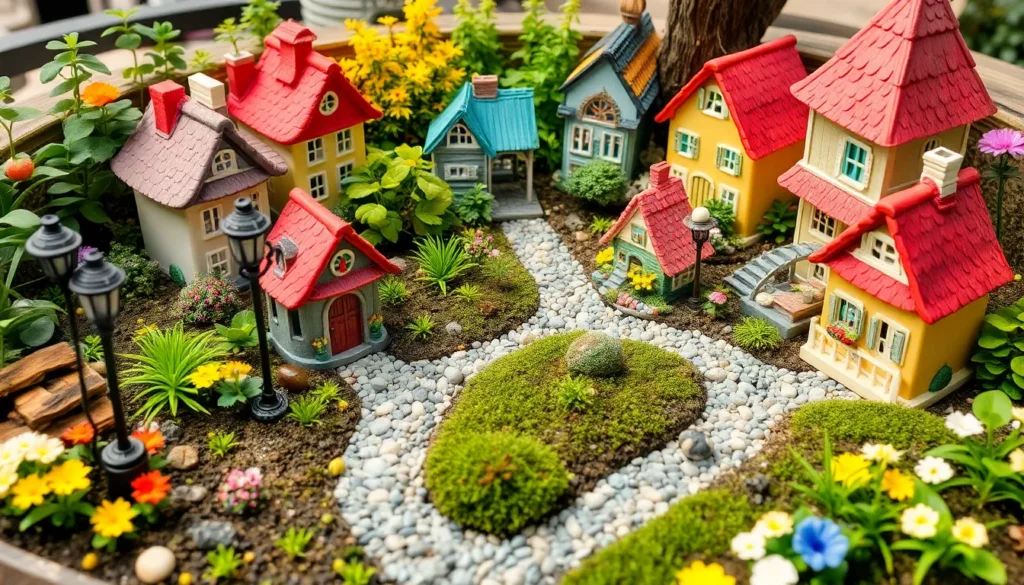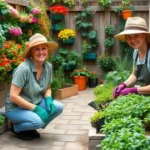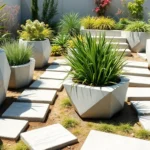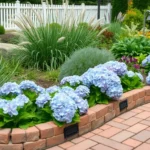Transform any small space into a magical miniature wonderland with creative gardening ideas that pack maximum impact into minimal square footage. Whether you’re working with a tiny balcony, desktop container, or forgotten corner of your yard, miniature gardens offer endless possibilities for expressing your creativity while connecting with nature.
We’ve discovered that these pint-sized paradises aren’t just adorable – they’re incredibly practical answers for urban dwellers, busy professionals, and anyone who wants to experience the joy of gardening without the overwhelming commitment of a full-scale industry. From fairy tale themes to modern succulent arrangements, miniature gardens let you experiment with design concepts and plant combinations in a manageable, budget-friendly way.
Ready to create your own enchanting miniature escape? We’ll share innovative ideas that transform ordinary containers into extraordinary living art pieces, proving that size doesn’t limit your gardening dreams.
Create a Fairy Tale Village Scene
Building on the foundation of container gardening magic, we can transform our miniature spaces into enchanting storybook settlements that capture childhood wonder.
Add Miniature Houses and Cottages
Fairy houses serve as the centerpiece elements that define our village atmosphere. Resin cottages with thatched roofs create authentic rustic charm while withstanding outdoor weather conditions. Ceramic fairy doors measuring 2-3 inches tall attach directly to tree trunks or container edges, establishing magical entry points throughout our garden scene.
Mushroom houses offer whimsical alternatives that blend naturally with plant environments. We position these 4-6 inch tall structures near moss beds or under small ferns to create realistic forest dwelling scenes. Wooden birdhouse miniatures painted in pastel colors add cottage charm while serving dual purposes as actual bird shelters.
Multi-level arrangements maximize our village storytelling potential by creating depth and visual interest. Stacking small houses on different container levels or using tiered plant stands allows us to showcase various architectural styles from Tudor cottages to Swiss chalets within the same miniature industry.
Include Tiny Pathways and Cobblestone Roads
Gravel pathways measuring 1-2 inches wide connect our village structures using aquarium gravel in natural stone colors. We create winding routes between houses by pressing the gravel gently into soil, establishing clear navigation through our miniature community. Fine pea gravel works particularly well for realistic texture and easy maintenance.
Stepping stone trails use flat river rocks or ceramic tiles cut into 1-inch circles to form charming walkways. Placing these stones 2-3 inches apart mimics human scale proportions in our fairy village setting. We can paint these stones with weather-resistant create paint to add color coordination with our overall garden theme.
Sand pathways offer budget-friendly alternatives that create smooth walking surfaces for our imaginary village residents. Colored sand from create stores allows us to design intricate patterns or simple straight roads between key village locations. We contain the sand using small twigs or thin wire borders to maintain clean pathway edges.
Install Small-Scale Street Lamps and Lighting
Solar-powered fairy lights provide eco-friendly illumination that automatically activates at dusk without requiring electrical connections. These miniature LED strings measure 6-8 feet long and feature tiny lantern-style covers that resemble authentic street lighting. We wrap them around small garden stakes or miniature lamp posts to create village street lighting.
Battery-operated lanterns offer portable lighting answers that we can relocate seasonally or for special occasions. These 2-3 inch tall lanterns come in Victorian, medieval, and contemporary styles to match our village architectural themes. Timer functions allow automatic on/off cycles that conserve battery life while maintaining consistent evening ambiance.
Glow-in-the-dark elements create magical nighttime effects using phosphorescent paint or specialized garden stones. We paint miniature house windows or pathway markers with glow paint that charges during daylight hours and emits soft green or blue light after sunset. These elements add enchanting touches that make our fairy village truly come alive in darkness.
Design a Desert Landscape Theme
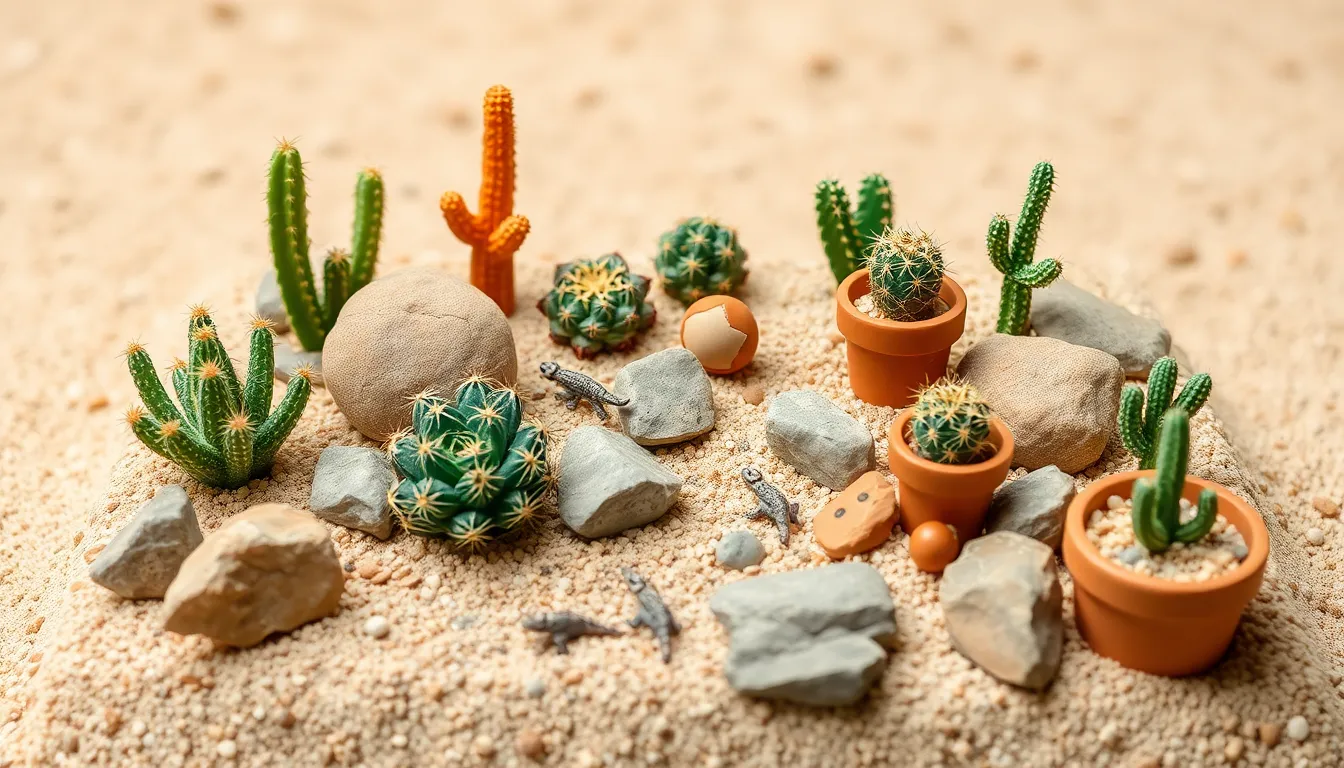
Creating a miniature desert industry offers us an entirely different aesthetic from fairy gardens while maintaining the same magical appeal. Desert themes bring stunning textures and unique plant forms that thrive in compact spaces.
Select Drought-Tolerant Succulents and Cacti
Small cacti varieties form the backbone of our miniature desert garden design. We’ll want to choose compact species like barrel cacti, small prickly pears, and tiny saguaro specimens that won’t outgrow their space. Succulents such as small aloe plants, echeveria rosettes, and crassula varieties add wonderful texture variety while requiring minimal water maintenance.
Arranging these plants requires strategic placement based on their growth patterns. We position taller cacti like mini saguaros toward the back or center as focal points, while spreading lower succulents like echeveria and small aloe around the perimeter. This layered approach creates natural depth and visual interest throughout our desert industry.
Plant selection should prioritize species that remain compact over time. We avoid fast growing varieties that might overwhelm our miniature space within months. Instead, slow growing specimens like barrel cacti and compact aloe varieties maintain their proportions for years with proper care.
Incorporate Sand and Rock Elements
Sand and rock elements provide essential drainage while creating authentic desert aesthetics in our miniature industry. We use small pebbles and coarse sand to fill gaps between plants, preventing water from pooling around sensitive root systems. These materials also reflect the natural desert floor appearance we’re trying to recreate.
Creating pathways with fine gravel or sand adds functional beauty to our design. We arrange small rocks in winding patterns that guide the eye through different sections of our desert garden. Larger accent stones can serve as natural barriers or focal points when positioned strategically.
Color coordination matters when selecting our sand and rock materials. We choose neutral tones like beige sand, gray pebbles, and reddish rocks that complement our plant colors without competing for attention. This approach ensures our succulents and cacti remain the stars of the display.
Add Miniature Desert Animals and Decorations
Desert animal figurines bring personality and storytelling elements to our miniature industry theme. We incorporate small lizard figures, tiny coyote sculptures, and miniature bird representations that you’d naturally find in desert environments. These elements create focal points and conversation starters for visitors admiring our garden.
Decorative accessories should complement rather than overwhelm our natural desert plants. We add small terracotta pots as accent pieces, perhaps containing additional tiny succulents or serving as purely decorative elements. Miniature lanterns or small decorative stones can enhance the theme without cluttering the space.
Scale remains crucial when selecting our decorative elements for the desert theme. We ensure all figurines and accessories match the proportions of our plants and containers, maintaining the illusion of a realistic miniature desert network. Oversized decorations quickly break the magical spell we’re working to create.
Build a Tropical Paradise Setting
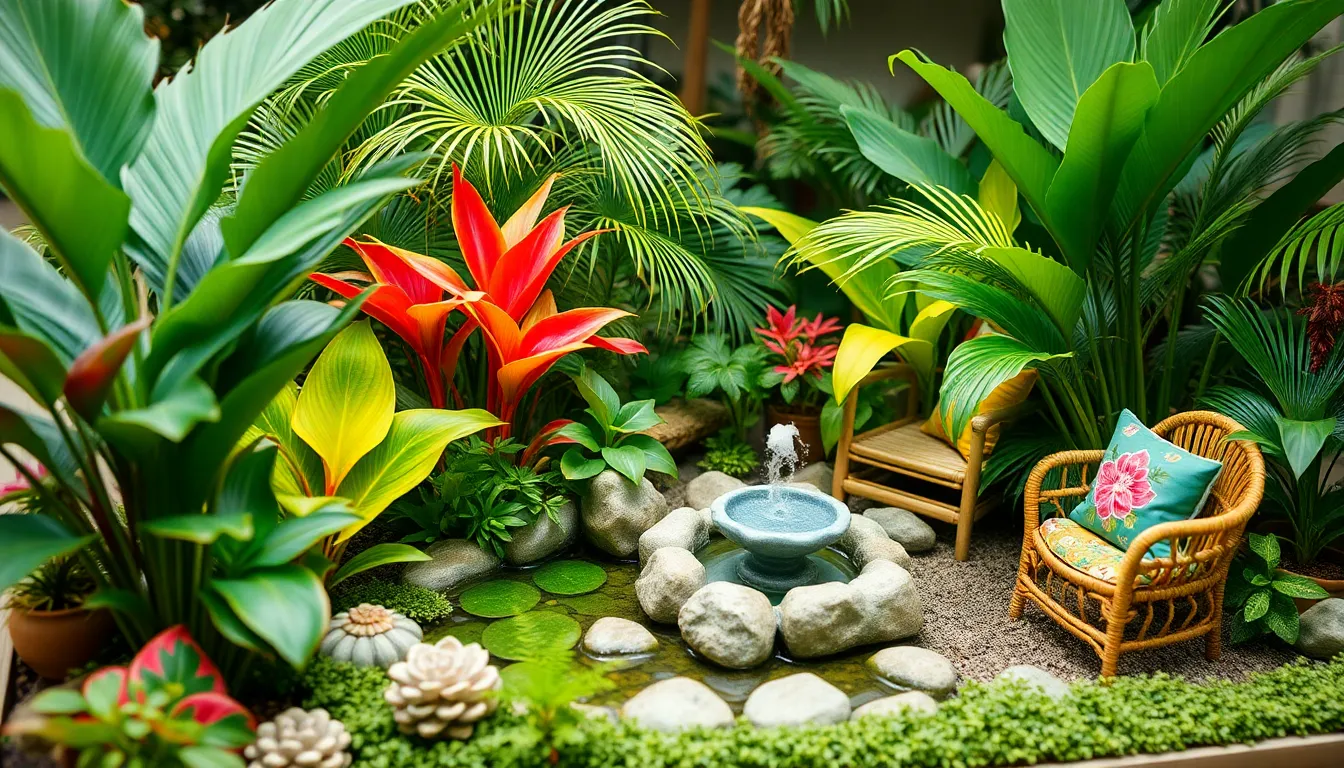
Transform your miniature garden into a lush tropical oasis that brings vacation vibes to any space. We’ll guide you through selecting dramatic plants, incorporating water elements, and adding authentic accessories that create an immersive tropical experience.
Choose Lush Green Plants and Palm Varieties
Select dramatic foliage plants like bananas, cannas, elephant ears, and palms to establish your tropical foundation. These statement plants provide the bold, architectural elements that define authentic tropical landscapes.
Layer your plant selections strategically by combining tall palm varieties with shorter tropical specimens to create depth and visual interest. Position taller palms toward the back of your container arrangement while placing medium-height cannas and shorter elephant ears in front.
Incorporate cool-zone alternatives with large-leafed plants and bright flowering varieties that mimic tropical environments even in temperate climates. Plants with oversized foliage and vibrant blooms successfully replicate the lush appearance of true tropical species.
Choose containers thoughtfully by selecting pots that complement your home’s aesthetic while ensuring proper drainage for optimal plant health. Variety in container sizes and styles adds visual complexity to your tropical display.
Create Water Features with Small Ponds
Add tranquil water elements through small ponds, waterfalls, or burbling fountains that recreate the serene atmosphere of a tropical vacation destination. These features become focal points that draw attention and create peaceful ambiance.
Enhance sensory experiences by incorporating water features that provide soothing sounds and reflective surfaces throughout your miniature tropical paradise. Moving water adds ever-changing visual interest while creating calming background sounds.
Position water features strategically within your container arrangement to maximize their impact and ensure they complement rather than overwhelm your plant selections. Small-scale fountains work particularly well as centerpiece elements surrounded by lush tropical foliage.
Include Tropical-Themed Accessories and Figurines
Incorporate tropical statues and figurines that enhance your garden’s authentic atmosphere without overwhelming the natural plant elements. These decorative pieces should complement your tropical theme while maintaining appropriate scale for your miniature setting.
Add resort-style accessories including colorful cushions, tropical-patterned textiles, and bamboo furniture pieces that create an immersive vacation ambiance. Wooden elements and natural materials reinforce the authentic tropical aesthetic.
Balance decorative elements carefully to ensure accessories support rather than dominate your plant displays. Each decorative piece should contribute to the overall tropical narrative while maintaining visual harmony with your living elements.
Construct a Zen Garden Retreat
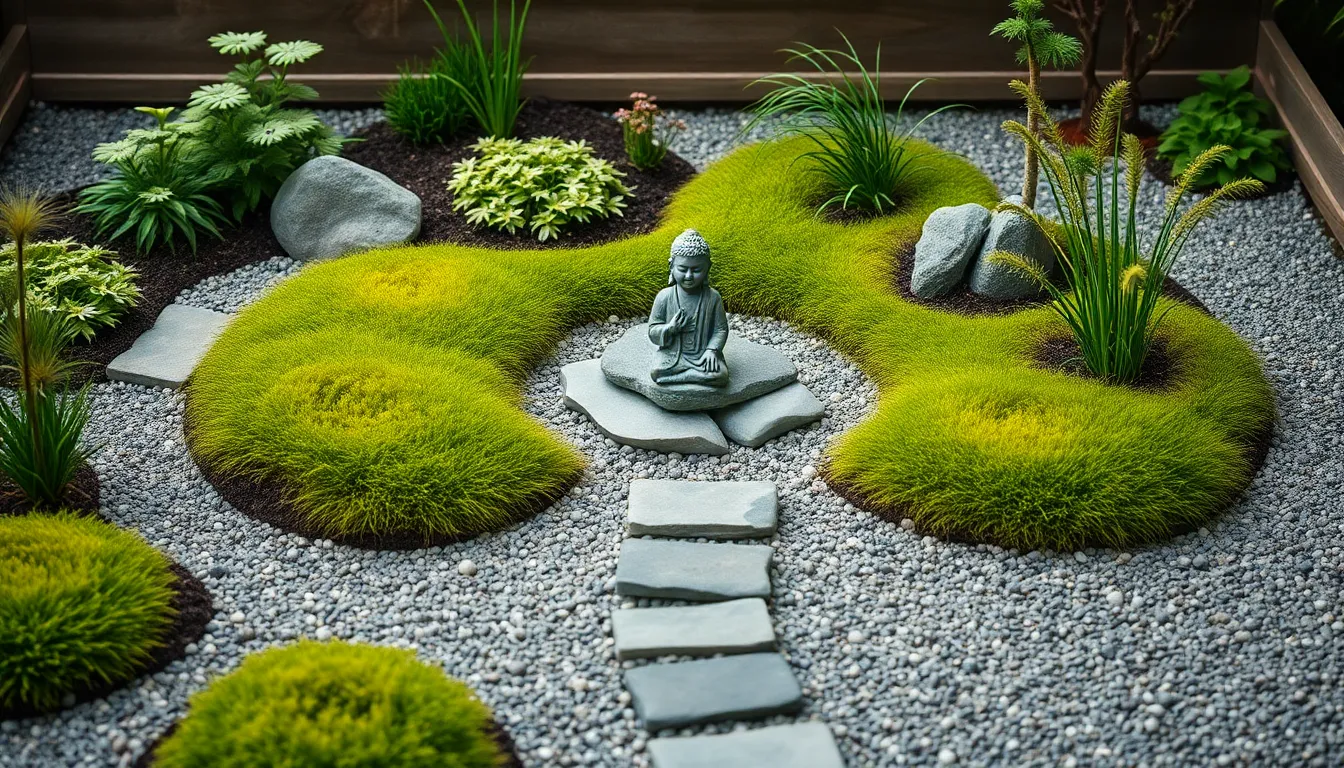
Building on our tropical paradise theme, we’ll now explore creating a serene Zen garden retreat that brings tranquility and mindfulness to your miniature gardening space. This peaceful sanctuary offers a stark yet beautiful contrast to previous vibrant themes.
Use Minimalist Plant Selections
Choosing the right plants sets the foundation for an authentic Zen garden experience. We recommend selecting plants that fit your garden’s scale, including mosses, sedums, sempervivums, and small grasses that naturally embody the minimalist aesthetic. Herbs like parsley, coriander, or rosemary serve as excellent mini trees or shrubs while adding aromatic benefits to your retreat.
Focus on plants with simple forms and muted colors that won’t overwhelm the peaceful atmosphere. Green mosses create soft carpeted areas that mimic larger Zen garden lawns, while small succulents provide structural interest without visual chaos. We suggest limiting your plant palette to 3-5 varieties maximum to maintain the essential simplicity that defines Zen design principles.
Add Meditation Elements and Stones
Incorporating contemplative features transforms your miniature space into a true meditation sanctuary. Small stones or pebbles create peaceful focal points that encourage reflection and mindfulness practice. We recommend adding a small statue or meditation stone to enhance the garden’s spiritual atmosphere and provide visual anchoring.
Stone arrangements should follow traditional Zen principles of asymmetrical balance and natural placement patterns. Position larger stones as primary focal points, then surround them with smaller pebbles to create visual flow and movement. These elements work together to establish the meditative quality that makes Zen gardens so captivating and restorative.
Create Peaceful Pathways with Gravel
Designing thoughtful pathways guides visitors through your miniature retreat while promoting mindful movement. Fine gravel or small stones create winding paths that encourage slow, contemplative walking through the garden space. We suggest adding stepping stones or small slabs to provide clear direction and prevent disruption of surrounding elements.
Rake patterns in the gravel create the iconic Zen aesthetic while symbolizing water flow and natural movement. These pathways should curve gently rather than follow straight lines, mimicking natural trail systems and encouraging visitors to slow down and appreciate each element. The contrast between smooth pathways and textured plant areas enhances the overall sensory experience of your Zen retreat.
Establish a Vegetable Garden Plot

We can transform our miniature gardens into productive food sources by incorporating edible plants that thrive in small spaces. Growing our own vegetables in miniature form allows us to enjoy fresh produce while maintaining the charming aesthetic of our tiny landscapes.
Plant Miniature Herbs and Vegetables
Cherry tomatoes make excellent focal points in our vegetable plots, providing vibrant color and continuous harvests throughout the growing season. We’ll find that baby carrots develop perfectly in shallow containers, requiring only 2-3 inches of soil depth for proper root formation. Leafy greens like lettuce and spinach create lush carpets of vegetation that serve dual purposes as both ornamental and edible elements.
Herbs transform our miniature spaces into fragrant cooking gardens while serving as structural elements in our designs. Parsley grows into perfect miniature shrubs that we can harvest regularly without compromising the garden’s appearance. Coriander provides delicate, feathery foliage that adds texture variation to our vegetable plots. Rosemary develops woody stems that mimic tiny trees, creating natural height variation in our compact growing spaces.
Radishes offer quick gratification since they mature in just 30 days, allowing us to enjoy rapid results from our miniature vegetable efforts. Baby cucumbers climb small trellises or supports, maximizing our vertical growing potential in limited horizontal space.
Install Tiny Garden Tools and Accessories
Miniature garden tools create authentic working garden atmospheres while remaining functional for our small-scale maintenance needs. We can create tiny pathways using small pebbles or crushed gravel to create realistic walkways between our vegetable rows. Twigs become natural supports for climbing plants like peas or tiny beans, maintaining the organic aesthetic of our edible landscapes.
Moss serves multiple purposes as ground cover and natural mulch around our vegetable plants while adding realistic forest floor textures. Bridges constructed from small sticks or purchased miniatures create charming focal points that suggest well-established garden spaces. Birdhouses attract beneficial insects that help pollinate our vegetable flowers, combining functionality with decorative appeal.
Tiny furniture like benches or chairs suggests human interaction with our productive spaces, telling stories of gardeners tending their crops. Miniature figurines positioned near vegetable plants create narratives about harvesting and garden care activities.
Create Small Greenhouse Structures
Glass containers repurposed as mini greenhouses extend our growing seasons by protecting tender seedlings from temperature fluctuations. We can position transparent plastic covers over our most delicate vegetables during cold snaps or extreme weather events. Mason jars inverted over individual plants create perfect mini-greenhouse environments that trap heat and humidity.
Small glass terrariums serve dual purposes as both protective growing environments and attractive display pieces for our miniature vegetable gardens. Plastic cloche covers designed for seedlings provide professional-grade protection while maintaining visual access to our growing plants. Clear storage containers with ventilation holes drilled in the tops create larger greenhouse spaces suitable for multiple vegetable varieties.
Transparent covers help us control moisture levels around humidity-loving vegetables like herbs and leafy greens throughout different seasons. These protective structures allow us to experiment with vegetables that might otherwise struggle in our local climate conditions.
Develop a Woodland Forest Scene
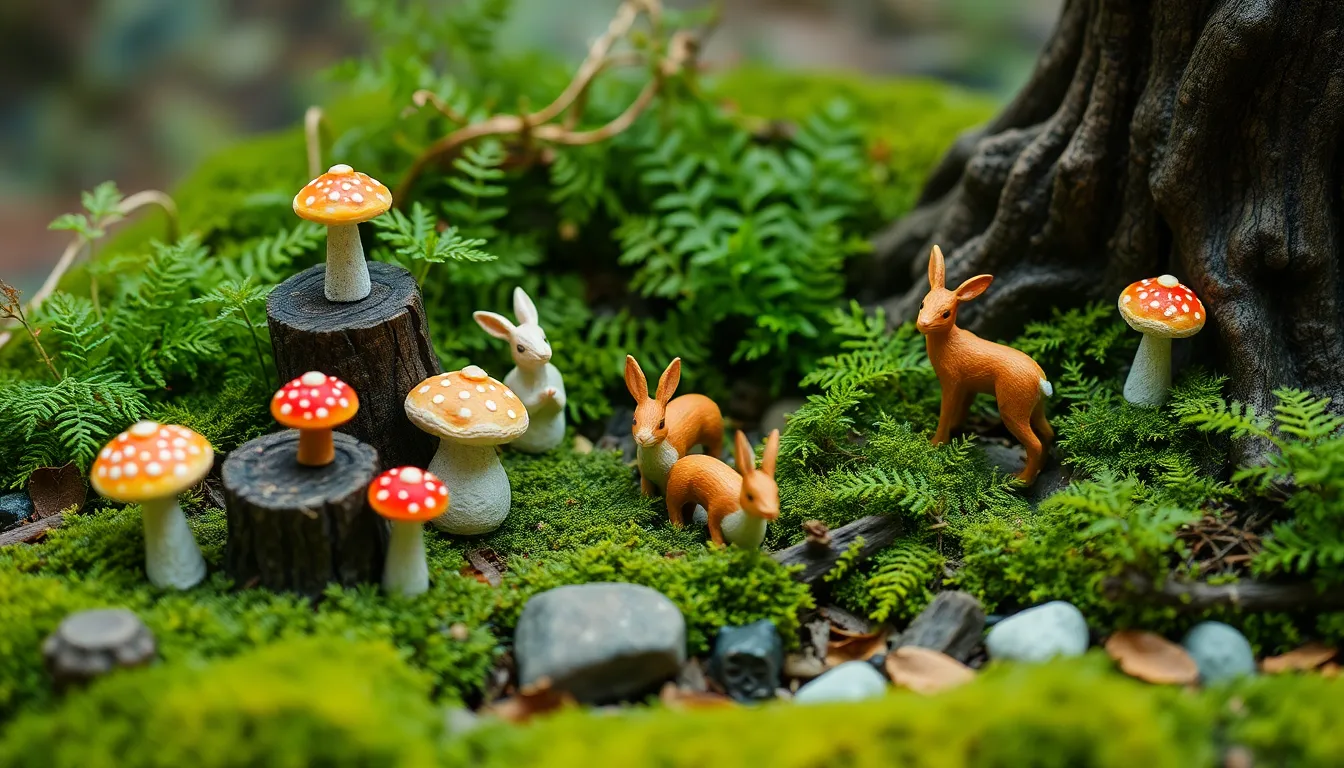
Creating a woodland forest scene brings the magic of nature’s floor into our miniature garden space. We’ll transform any shallow container into a lush forest network that captures the essence of walking through a shaded woodland path.
Select Moss and Fern Varieties
Moss varieties form the foundation of our woodland forest floor, creating that dense carpet effect we see in natural forests. Sphagnum moss provides excellent moisture retention while establishing a realistic forest base that supports other plantings. Peat moss offers similar benefits and creates varying textures across our miniature industry.
Fern species add vertical interest and authentic woodland character to our scene. Maidenhair ferns thrive in the shaded conditions we’re creating and maintain their delicate appearance in small spaces. Autumn ferns provide seasonal color changes that keep our woodland scene ever-changing throughout the year.
Small fern varieties work best since they won’t overwhelm our container space while still providing that classic forest understory look. We can layer different moss types to create natural variations in color and texture that mimic real forest floors.
Add Tree Stumps and Mushroom Decorations
Tree stumps anchor our woodland scene and provide focal points that draw the eye through our miniature forest. Natural stumps work beautifully, but artificial options give us more control over size and placement within our container. We can hollow out these stumps to create hiding spots that add mystery to our woodland story.
Mushroom decorations enhance the forest floor ambiance with pops of color and whimsical charm. Small artificial mushrooms in various colors like red, brown, and white create realistic forest scenes while adding visual interest. We should scatter them naturally around our moss base rather than placing them in obvious patterns.
Positioning these elements requires careful consideration of scale and natural placement. Tree stumps work best as background or side elements, while mushrooms can dot the foreground to create depth in our miniature industry.
Include Forest Animal Figurines
Forest animal figurines bring life and movement to our woodland scene, creating stories within our miniature industry. Rabbits, squirrels, and deer work particularly well since they’re commonly found in woodland environments and are available in appropriate scales for our containers.
Placement strategy matters more than the number of figurines we use in our scene. We should position animals among plants and stumps to create natural interactions, like a rabbit peeking out from behind a fern or a deer grazing near our moss carpet.
Detailed figurines add authenticity to our woodland scene, but we need to ensure they’re proportional to our other elements. We can create movement by positioning some animals as if they’re walking along invisible forest paths through our miniature industry.
Design a Beach Coastal Theme
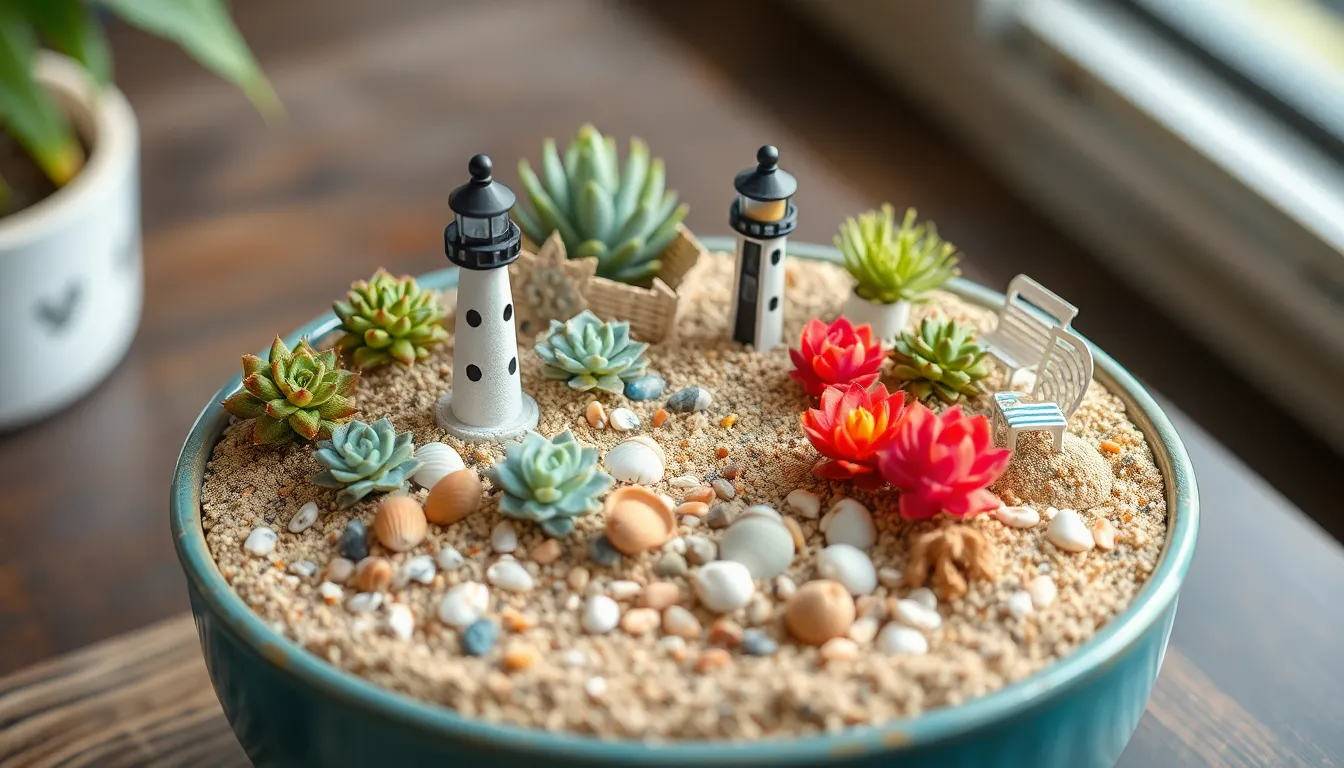
Transform your miniature garden into a coastal paradise by embracing the serene beauty of ocean landscapes. We’ll guide you through creating an enchanting beach themed retreat that captures the essence of seaside living.
Use Sand and Shell Decorative Elements
Play sand serves as the foundation for your miniature beach garden, creating authentic coastal textures that immediately transport viewers to the shoreline. Spread a thin layer across your container’s surface to establish the base industry. Sea glass pieces add sparkling accents that catch light beautifully, mimicking the way ocean waves polish glass fragments along real beaches.
Marbles create stunning water effects when arranged strategically throughout your design, with blue varieties representing pools and streams. Scatter various sized shells like tiny conch shells, scallop shells, and sand dollars to enhance the beachy atmosphere. These natural elements work together to build visual depth while maintaining the coastal color palette of blues, greens, and sandy neutrals.
Coarse sand pathways guide the eye through your miniature coastal industry, creating movement and exploration opportunities within the confined space. Layer different textures by combining fine sand with small pebbles to represent various beach zones from smooth shores to rocky tide pools.
Plant Sea-Loving Vegetation
Succulents perfectly replicate coastal vegetation due to their drought tolerant nature and unique textures that mirror plants found in seaside environments. Choose varieties like jade plants, echeveria, and string of pearls that naturally thrive in sandy conditions. These low maintenance plants require minimal watering, making them ideal for busy gardeners who want lasting beauty.
Arrange your plant selections strategically to create natural looking clusters that resemble how coastal vegetation grows in windswept dunes. Position taller succulents toward the back of your container while placing shorter varieties in front to establish depth. The varied heights and textures of these sea loving plants create visual interest without overwhelming the miniature scale.
Green and blue toned plants enhance the coastal color scheme while providing living elements that change and grow over time. Consider adding small ornamental grasses that sway gently, mimicking beach grass movements in ocean breezes.
Add Lighthouse and Boat Accessories
Miniature lighthouses serve as focal points that immediately establish your beach theme while adding vertical interest to the horizontal industry. Choose lighthouses made from wood or ceramics that complement your container’s size and color scheme. Position these iconic coastal structures strategically to create natural viewing angles and storytelling opportunities.
Boat accessories bring maritime charm to your coastal scene, with options ranging from tiny sailboats to fishing vessels that reflect different coastal lifestyles. Place boats partially buried in sand or positioned along shoreline areas to suggest they’ve been pulled ashore. These nautical elements work especially well when paired with miniature anchors, rope coils, or fishing nets.
Additional beach themed accessories like mini beach chairs, driftwood pieces, and tiny umbrellas complete the coastal narrative while maintaining proper scale relationships. Distribute these decorative elements thoughtfully to avoid overcrowding while ensuring each piece contributes to the overall beach atmosphere you’re creating.
Create a Medieval Castle Setting
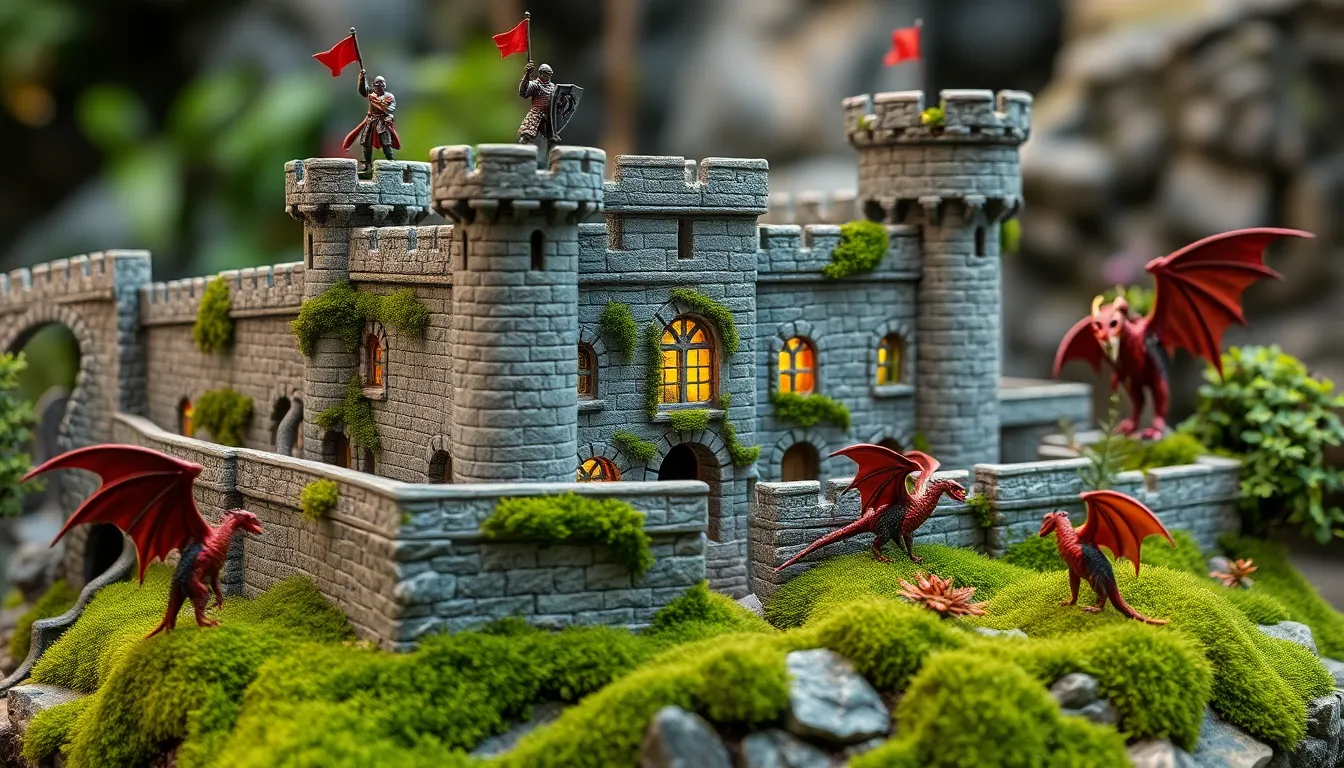
Transform your miniature garden into an enchanting area of knights and dragons with these authentic medieval elements. We’ll guide you through creating a dramatic castle scene that brings historical fantasy to life in compact spaces.
Build Castle Structures and Towers
Start with foam board or cardboard as your primary construction material for building realistic castle walls. Design a basic drawing first to visualize your structure’s size and complexity before cutting materials. Stone effect plaster adds authentic texture to walls and creates weathered surfaces that look centuries old.
Add detailed elements like arched windows, heavy wooden doors, and crenellated battlements along the castle walls. Position towers at strategic corners to create defensive strongholds that mirror actual medieval architecture. Create a drawbridge using thin wood strips and string to complete the fortress entrance.
Consider multiple levels within your castle design to maximize visual impact in limited space. Build interior courtyards using small stones or gravel to separate different castle sections. Paint structures in muted grays and browns to achieve that authentic aged stone appearance that defines medieval fortifications.
Include Knight and Dragon Figurines
Place knight figurines near castle entrances or positioned on battlements as vigilant guards protecting the area. Select figures in different poses like charging with lances, standing at attention, or engaged in sword combat to create ever-changing storytelling scenes.
Position dragon figurines in dramatic attacking poses near the castle walls or coiled around towers guarding hidden treasure. Choose dragons in various sizes to create hierarchy within your miniature industry. Large dragons can dominate central areas while smaller ones hide in shadowy corners.
Create interactive scenes between knights and dragons by positioning them in confrontational stances. Mount some knights on horseback to add movement and scale variation to your medieval tableau. Mix different armor styles and dragon colors to represent various kingdoms and mythical creatures from medieval lore.
Add Medieval-Themed Landscaping Elements
Use moss to create lush green landscapes around your castle that simulate the wild countryside of medieval times. Spread moss naturally around stone pathways and castle foundations to achieve organic growth patterns. Add various stone sizes to form cobblestone roads and defensive barriers.
Incorporate miniature trees and shrubs around the castle perimeter to create dense forest effects that medieval castles often featured for protection. Plant small evergreen varieties that maintain their appearance year round. Arrange vegetation strategically to frame castle views while maintaining clear sight lines.
Install a mist maker near water features or hidden within landscaping to create mystical atmospheric effects reminiscent of foggy medieval mornings. Add small LED lights within castle structures to illuminate windows and create magical nighttime ambiance. Scatter tiny pebbles to form realistic pathways connecting different areas of your medieval kingdom.
Construct a Modern City Miniature
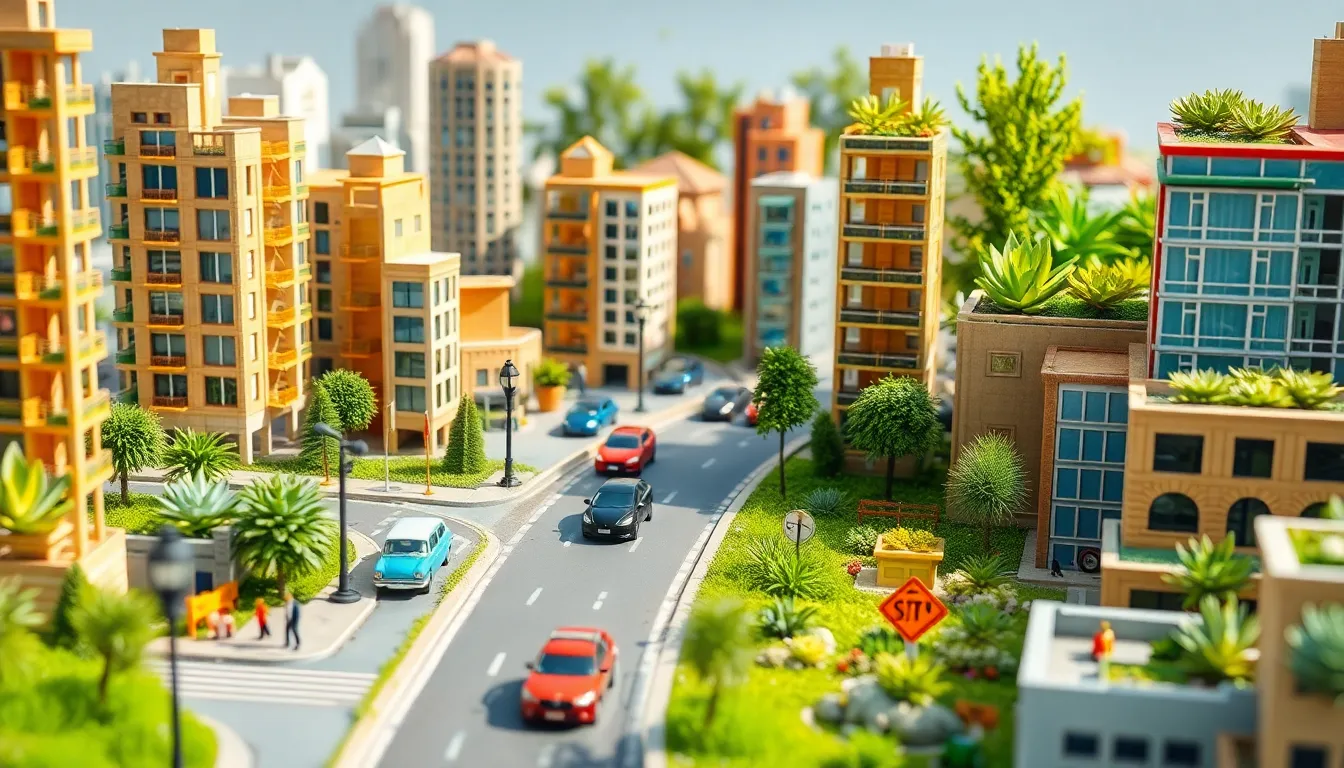
Urban environments offer incredible inspiration for miniature garden design. We’ll explore how to transform your container into a bustling metropolitan scene that captures the energy and sophistication of city living.
Design Urban Building Structures
Building miniature skyscrapers requires careful material selection and attention to architectural detail. We recommend using lightweight materials like cardboard, clay, or resin to create office buildings, residential towers, and mixed-use structures. Cardboard provides excellent flexibility for beginners, while clay offers durability for long-term displays.
Detailing transforms basic structures into realistic urban landmarks. We add windows using small squares of clear plastic or painted rectangles, creating the illusion of lit offices and apartment units. Doors at ground level complete the authentic building appearance, while architectural features like balconies and rooftop equipment enhance the metropolitan atmosphere.
Scaling ensures your cityscape maintains proper proportions within the container. We suggest keeping buildings between 3-6 inches tall, varying heights to create an authentic skyline silhouette. Multiple building types including residential apartments, office towers, and commercial structures add diversity to your urban industry.
Create Street Scenes with Vehicles
Transportation elements bring life and movement to your miniature city design. We incorporate small cars, buses, and bicycles positioned along designated roadways to simulate active urban traffic. Die-cast vehicles work perfectly for this scale, providing realistic details without overwhelming the space.
Infrastructure components complete the street scene authenticity. We install miniature streetlights using small LED lights or painted toothpicks, creating the essential urban lighting network. Traffic signals made from tiny beads or painted details add functional realism to intersections.
Pedestrian elements encourage storytelling within your city scene. We create walkways using thin strips of gray material or painted surfaces, connecting different areas of the urban environment. Crosswalks marked with white lines and small pedestrian figures enhance the street-level experience.
Add Contemporary Landscaping Features
Modern cities integrate green spaces that soften urban hardscapes. We incorporate rooftop gardens using small succulent plants or moss patches positioned on building tops, reflecting current sustainable city planning trends. These elevated gardens create visual interest while maintaining the contemporary aesthetic.
Urban parks provide breathing room within dense city environments. We design small green spaces using moss, tiny plants, or artificial grass, creating pocket parks that city dwellers would recognize. Miniature benches and walking paths complete these essential urban amenities.
Vertical gardens reflect modern eco-friendly building practices. We attach small plants or moss to building sides, simulating living walls that many contemporary structures feature. These green elements balance the concrete and steel aesthetic while demonstrating sustainable urban design principles.
Conclusion
We’ve explored countless ways to transform ordinary containers into extraordinary miniature worlds that spark imagination and bring joy to any space. From whimsical fairy villages to serene Zen retreats each theme offers unique opportunities to express creativity while working within budget-friendly constraints.
The beauty of miniature gardening lies in its accessibility and endless possibilities for customization. Whether you’re drawn to productive vegetable plots bustling medieval castles or tranquil coastal scenes there’s a perfect miniature garden waiting to come to life in your home.
Start small choose a theme that resonates with your personality and let your creativity guide the process. With just a few carefully selected plants some thoughtful accessories and a dash of imagination you’ll soon discover the therapeutic joy of nurturing these tiny landscapes that pack enormous visual impact.
Frequently Asked Questions
What are miniature gardens and who are they perfect for?
Miniature gardens are small-scale gardening projects created in containers that transform limited spaces into enchanting living art pieces. They’re perfect for urban dwellers, apartment residents, and busy individuals who want to enjoy gardening without significant space or time commitments. These tiny landscapes maximize impact in minimal areas while being budget-friendly and easy to maintain.
How do I create a fairy tale village in my miniature garden?
Start by incorporating miniature houses, resin fairy cottages, and ceramic doors to establish a whimsical base. Create multi-level arrangements using small containers and add tiny pathways with gravel or stepping stones. Install solar-powered fairy lights or glow-in-the-dark elements for magical nighttime ambiance. Layer different sized elements to create depth and storytelling potential.
What plants work best for miniature desert landscapes?
Choose small cacti varieties and slow-growing succulents that thrive in compact spaces. Select drought-tolerant plants like small barrel cacti, jade plants, and echeveria. Arrange them strategically to create visual depth and coordinate colors for enhanced appeal. These plants require minimal water and maintenance while providing unique textures and forms.
How can I design a tropical paradise miniature garden?
Use lush green plants and small palm varieties as your foundation, layering different plant selections for depth. Incorporate small water features like tiny ponds or fountains for sensory appeal. Add tropical-themed accessories and figurines that complement your plants while maintaining proper scale. Focus on creating vibrant colors and varied textures to evoke vacation vibes.
What elements are essential for a Zen garden retreat?
Keep plant selections minimalist with mosses, sedums, and small grasses, limiting your palette to 3-5 varieties. Incorporate meditation elements like small stones, miniature statues, and thoughtful gravel pathways. Create raked patterns in sand or small stones to achieve the iconic Zen aesthetic. Focus on simplicity, balance, and elements that promote tranquility and mindfulness.
Can I grow edible plants in miniature gardens?
Yes! Cherry tomatoes, baby carrots, and leafy greens work excellently in miniature vegetable plots. These plants serve dual purposes as both ornamental and edible elements. Use miniature garden tools and accessories to create realistic working environments. Consider small greenhouse structures to protect seedlings and extend growing seasons while maintaining the miniature aesthetic.
How do I create a woodland forest scene?
Transform shallow containers using moss and fern varieties to create realistic forest floors. Add tree stumps, mushroom decorations, and forest animal figurines for authentic woodland ambiance. Layer different heights and textures to simulate natural forest environments. Focus on creating depth through careful placement of elements that tell woodland stories.
What materials work best for building castle structures?
Use lightweight materials like foam board or cardboard to construct castle buildings. Add detailed elements such as arched windows and crenellated battlements for authenticity. Include knight and dragon figurines for dynamic storytelling scenes. Enhance the medieval atmosphere with moss, miniature trees, mist makers, and LED lighting for magical ambiance.
How do I design a modern city miniature garden?
Create urban building structures using cardboard and clay, focusing on realistic skyscrapers and office buildings. Pay attention to scaling and detailing for authenticity. Incorporate miniature vehicles and street infrastructure for realism. Add contemporary landscaping features like rooftop gardens and urban parks to reflect modern sustainable design principles and urban sophistication.

